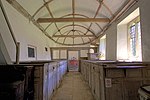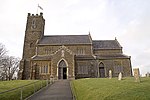Winterborne Zelston

Winterborne Zelston is a village and civil parish in north Dorset, England. It is situated in a winterbourne valley on the A31 road eight miles (thirteen kilometres) south of Blandford Forum and 10 mi (16 km) northwest of Poole. The parish had a population of 141 in 2001. In 2013 the estimated population of the civil parish was 90.The first name of "Winterborne" comes from the River Winterborne, which flows from west to east through the village. Zelstone is probably from the name of the Zeals family. The river only flows overground during the winter, hence the name. To the west is Winterborne Tomson and to the north-east is Almer. The river flows through both these villages as well.
Excerpt from the Wikipedia article Winterborne Zelston (License: CC BY-SA 3.0, Authors, Images).Winterborne Zelston
The Street,
Geographical coordinates (GPS) Address Nearby Places Show on map
Geographical coordinates (GPS)
| Latitude | Longitude |
|---|---|
| N 50.7774 ° | E -2.146 ° |
Address
The Street
The Street
DT11 9EU
England, United Kingdom
Open on Google Maps







